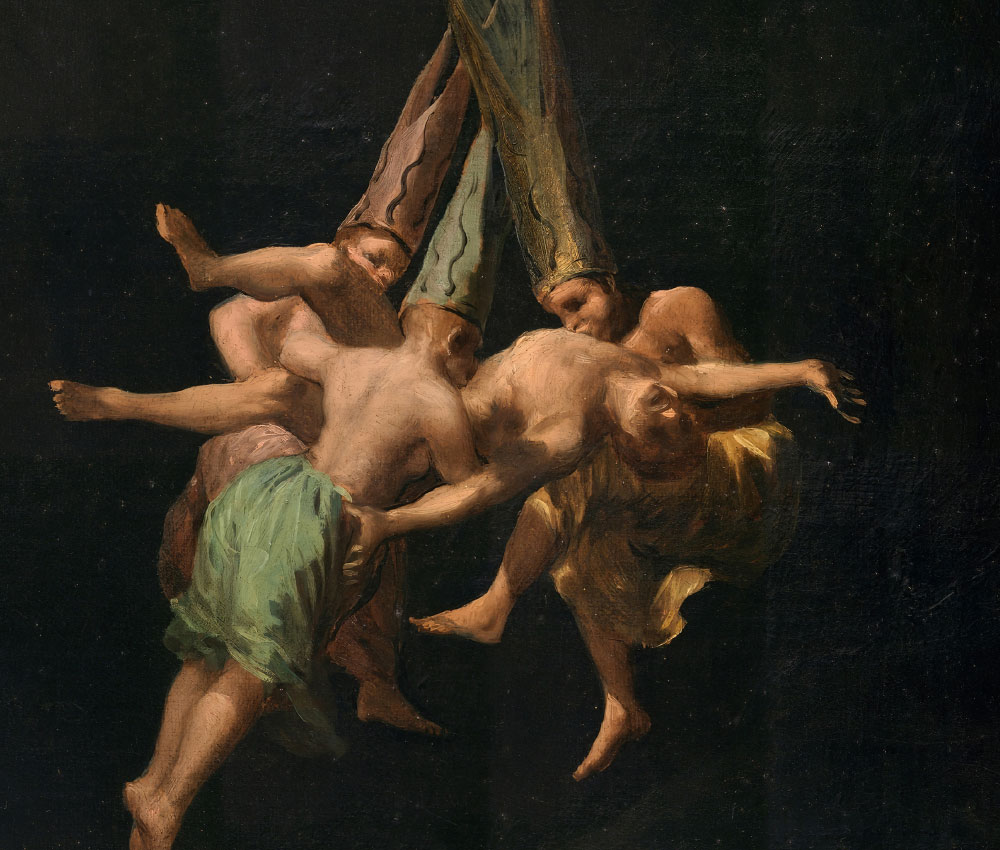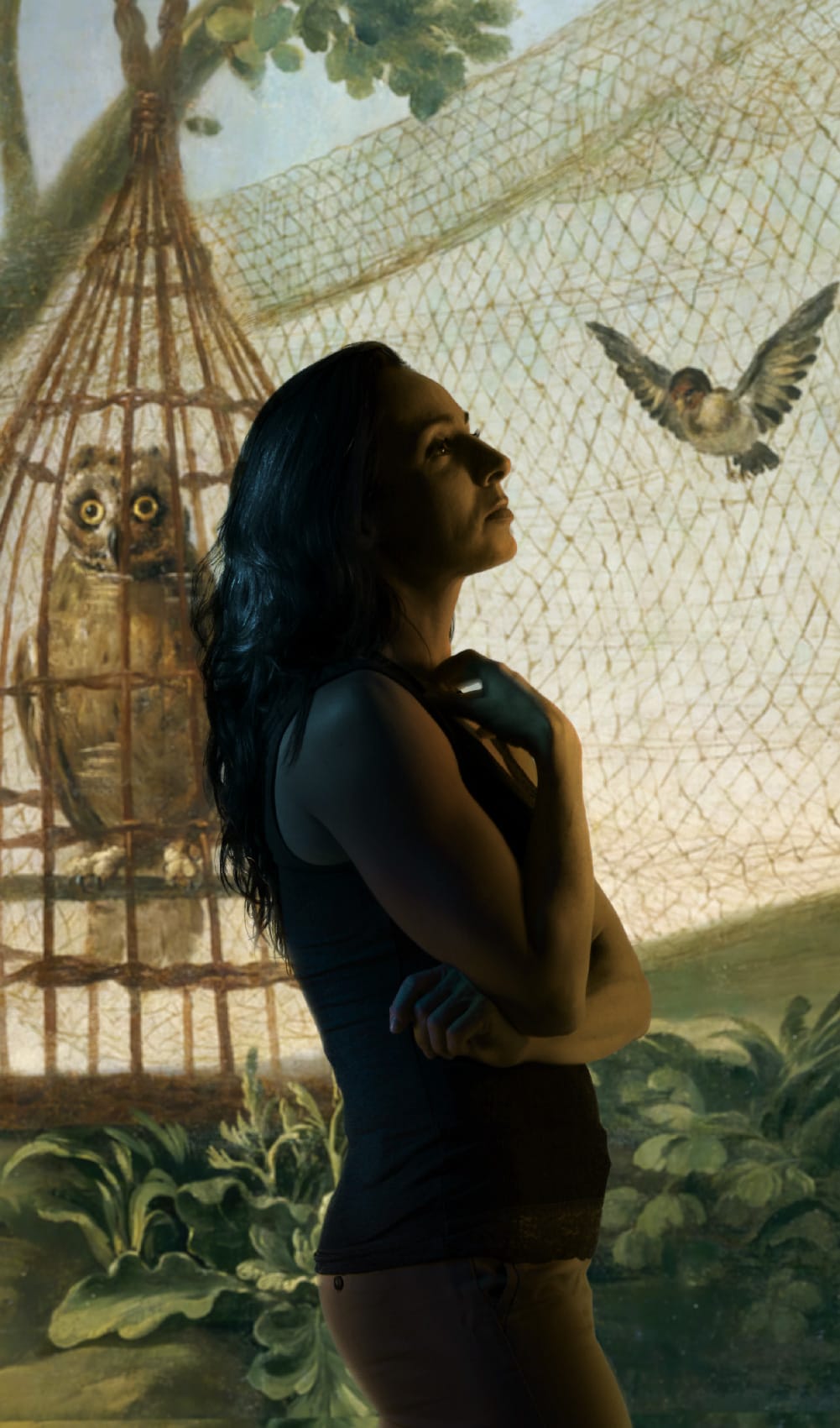
The Witches’ Flight
The small canvas traditionally called Witches’ Flight forms part of a group of six paintings that Goya sold to the dukes of Osuna in 1798 for El Capricho, the duchess’ recreational palace, located on her property in La Alameda on the outskirts of Madrid.
In his receipt, Goya described these paintings as “compositions of affairs of Witches”, characters that play a lead role in four of the canvases, while the other two have to do with literary subjects related with spectral figures.
This type of subject was also being developed in other European countries as a result of the effects of the French Revolution and the loss of confidence in the values of the Enlightenment, which fostered, on the contrary, a whole series of subjects on the limits of reason, like notions of dread, lack of control, monstrosity, the grotesque, or fantasy, as seen in the works of artists like Johann Heinrich Füssli in Switzerland, Caspar David Friedrich in Germany, or William Blake in England.
In parallel to this series of paintings, Goya was working on similar themes in his Caprichos, that he published a year later. But he, like the dukes of Osuna, who were the most important enlightened nobles of their time, used the fascination for witches and other similar evil beings to criticize the superstition and ignorance brought on by the lack of education. Some years earlier, in 1792, in a letter to his friend Martín Zapater, Goya had already manifested his position in this sense, saying: “I don’t fear witches, spirits, ghosts, bullying giants, brawls, or scoundrels, etc. nor any class of bodies do I fear except humans.”
As in his engravings, Goya made use of satire and caricature in these paintings to denounce the problems and vices of a society that was victim to the abuses of the highest social strata, in this case, the clergy, and particularly the Inquisition, one of its most criticized manifestations at that time, an institution that even at that time had registered several accusation processes for witchery.
It has been said that of all of Goya’s representations of this subject, Witches’ Flight is one of the most sinister and terrifying, and at the same time one of the most beautiful and powerful. It is without doubt one of the most enigmatic, and numerous are the interpretations that have attempted to explain it.
The scene appears to take place at night, in an elevated area, where two countrymen have arrived by way of a path that fades into the distance. One of the men is lying on the ground, face down, covering his ears, while the other, standing in the center of the composition, covers his head with a white blanket while moving forward with his arms extended and making a mano fico gesture with both hands as a sign to ward off the evil eye. They try to not hear or see, to not fall under the spell of the group that is levitating over their heads. The group is formed by three witches or warlocks with bare chests, as penitents tended to be, and wearing coned hats that resemble episcopal mitres decorated with snakes. The three beings hold a naked man, and they seem to be sucking his blood. To the lower right, a donkey, the traditional symbol of ignorance, waits apathetically for his owners. The bright light that comes from outside of the composition dramatically highlights both groups while the rest remains in darkness.
For some authors, this detail would confirm that the upper scene, more brightly lit, would be a figment of the countrymen’s imagination or delirium, perhaps scared as night has fallen and they confuse any sound or shadow with something evil.
Other interpretations assume that the witches or warlocks are not sucking, but rather blowing, insufflating their breath into the victim, which would make this a scene of a demonic possession, in which the devil would have already entered the man’s body, which shakes convulsively. These occurrences were rejected by the enlightened as false, and Goya would be expressing this with absurdity and ridicule.
The subject has even been associated with freemasonry based on the presence of the serpents on the coned hats, considered symbols of wisdom among the freemasons, as were the climbing of a mountain, the contrast between light and dark, and believing that Goya illustrates, perhaps critically, the adoption of this practice by the aristocracy and leading, cultured class, while the countrymen in the lower part cover their ears and refuse to listen to the truth about witches/priests. However, there is no evidence that the dukes of Osuna had any relation with freemasonry.
Another explanation centers on the coned hats in the form of episcopal mitres, through which Goya could be identifying the clergy as the real evil beings that suck the blood of their parishioners or insufflate them with erroneous ideas meanwhile limiting the development of rationalism that could combat widespread ignorance, an interpretation that would align with several of his Caprichos.
The six paintings of “affairs of witches” remained in the House of Osuna collection until the auction of their belongings in 1896, when they were dispersed. Witches’ Flight is housed in the Prado Museum; the so-called Witches’ Sabbath and The Spell are part of the Fundación Lázaro Galdiano collection in Madrid, and The Bewitched Man is in the National Gallery in London; the location of The Witches’ Kitchen and Don Juan and the Commander are unknown.
In his series of later drawings and engravings, Goya would eliminate the representation of fantastical beings to concentrate on the deeds of human beings, some just as terrible or more frightening that those committed by the unreal. The demonic figures would not reappear until two decades later, in the Black Paintings of the Quinta del Sordo (Deaf Man’s Villa).


